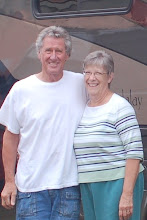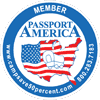January 19, 2008
Getting ready to leave involves considerable discussion. The guy talking to Dan is Ivan Williams, a friend of Larry and Phyllis. He and his wife, Grace, are spending several months on Dauphin Island.
 Kasey in his favorite spot in the motorhome, overseeing the "getting ready to go" process. "Are they ready yet?"
Kasey in his favorite spot in the motorhome, overseeing the "getting ready to go" process. "Are they ready yet?"
 Entering Florida
Entering Florida
Since we stopped to visit the Pensacola Naval Air Museum on our way to our next campsite, we arrived after dark at Pine Lake RV Park. We don't like to do this, since it seems to be a setup for parking and hookup problems, but all went well. This is a Passport America park, so our Full Hookup (FHU) rate is $15. All sites are pull through. We have plenty of room for the truck in front of the motorhome.
We have a lifetime membership with Passport America; so after paying $300 two years ago, no more annual fees. We stayed in several PA parks since then and have probably saved about half of the $300 so far. When we start fulltiming, we stay in even more PA parks. Many PA parks are off the beaten path, but that's OK with us as we plan to avoid Interstates as much as possible. We also really like Corps of Engineer parks and with our federal Golden Age Passport, COE fees are half price for us. And, some state parks offer senior citizen rates.
The National Museum of Naval Aviation at Pensacola, Florida is huge. Admission is free, so that fits our budget. There is so much to see; we could have spent a whole day there.
 The latest Blue Angel Pilot (wannabee). Notice there are no wings or engines and the rear of the plane is missing. I think we are pretty safe.
The latest Blue Angel Pilot (wannabee). Notice there are no wings or engines and the rear of the plane is missing. I think we are pretty safe.
We did fly the F-14 Tomcat flight simulator. Since the F-14 has been retired, the museum uses the REAL F-14 flight simulators that the pilots trained on. Dan was the pilot and I was the munitions officer. This was just like sitting in a real F-14. Look out, Top Gun Tom Cruise.
Dan really did pretty well with 3 successful airstrip landings in a row. BUT, we never did land on the aircraft carrier. Guess he's not quite ready for the big leagues yet. But, I must clarify -- the control stick was not as responsive as it would have been when the pilots were learning because people have played with them a lot and they are pretty loose.
Link Trainer
 I was especially interested to see this Link Trainer. My aunt, Hazel Rishel, was in the WAC (Women's Army Corps) during World War II. She was stationed in Japan, California, Aberdeen Proving Ground in Maryland and other places that I've forgotten. My mother always said that Aunt Hazel was a "Link Trainer" and trained pilots to fly. I never knew for sure what that involved, so I'll share what I learned about that.
I was especially interested to see this Link Trainer. My aunt, Hazel Rishel, was in the WAC (Women's Army Corps) during World War II. She was stationed in Japan, California, Aberdeen Proving Ground in Maryland and other places that I've forgotten. My mother always said that Aunt Hazel was a "Link Trainer" and trained pilots to fly. I never knew for sure what that involved, so I'll share what I learned about that.
Aunt Hazel was not actually the Link Trainer, but must have been an instructor or operator teaching cadets to fly by instruments. The Link Trainer was used to teach the pilots to learn how to rely on their instruments. Most of the Link Trainer operators were females, part of the Women Accepted for Voluntary Service (Waves), in the case of naval aviation.
The seat in the Link Trainer is about 3 feet off the floor, but once the pilot was strapped in and the top closed, they felt like they were in a real plane. The trainer was designed by a former organ manufacturer, turned pilot, named Edwin C. Link. The trainer could simulate various conditions that might be encountered in real flight, including wind drift, turbulence and radio static. The trainer could also put the aircraft in various flight orientations, including spins that required the student to right his "airplane". Air nozzles even produced the sound effect of the slipstream.
The goal of the Link Trainer was to force the student pilot to rely on his instruments or follow the instructions given by the operator to get his plane back safely to base. The Link Trainer was very cost effective. In 1945 each hour of flight in a training aircraft cost $10; it cost only 4 cents for an hour in the Link Trainer. But most importantly, no cadet could lose his life in a Link Trainer if he made a mistake, or crash an airplane. HOWEVER, an army Air Forces cadet found himself lost and low on fuel during his simulation. Following standard procedure, he threw open the hood, and bailed out, breaking his ankle when he hit the floor 3 feet below. :)
The Link Trainers used at Pensacola Naval Air Station were placed in storage in 1950 in a rodent infested, leaky hangar. In 1990 they were recovered by the museum. They were dirty and many of the wooden components were rotten. But, when plugged into a wall outlet and connected to a vacuum cleaner to provide power to the bellows, they still worked, except for a couple of instruments.
I hope you enjoyed the story of the Link Trainer. Whenever my mother talked about her sister, she always said with a lot of pride, "Hazel was a Link Trainer during the war. She taught pilots to fly." I never asked her to explain to me what a Link Trainer was and I'm not sure she really understood what Aunt Hazel did.
So as we continue our travels maybe we'll come across something else that provides a link to our past and helps us understand it better.









1 comment:
Hi, looks like you have your photo problem solved. This blog seems to work good - if I can figure how to send it back! lol Interesting story about your aunt! You did a lot more research than we did! We moved quicker than anyone else we know! Lynda
Post a Comment